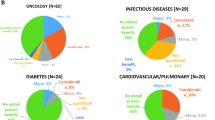Abstract
Government development of new medicines has recently received attention as a means of lowering drug prices. These proposals are generally based on the assumption that the private market charges prices that are higher than justified by the costs of development. Although some costs could be avoided through government drug development, most costs would remain unchanged and some could potentially increase. Inefficiencies that are more difficult to quantify are likely to worsen with greater government involvement in research allocation decisions, including lobbying by industry or patient groups. Government manufacturing is an alluring proposition, but is unlikely in the long term to improve new drug development or lower costs.
Similar content being viewed by others
References
Brown D. Medicine for all. Democracy Collaborative. September 2019. https://democracycollaborative.org/sites/default/files/styles/full_width_640px/public/pdfpreview/8352-MedicineforAll_WEB%20%282%29.png?itok=l_ENgW5J.
Stevens AJ, et al. The role of public-sector research in the discovery of drugs and vaccines. NEJM. 2011;364(6):535–41.
Ledley F, et al. Profitability of large pharmaceutical companies compared with other large public companies. JAMA. 2020;323(9):834–43.
WSJ tax guide 2019: The drug industry; the tax overhaul has given pharmaceutical companies that generate hefty sales outside the U.S. the chance to bring cash home at a preferential rate. Wall Street Journal, 15 February 2019.
Schwartz LM, Woloshin S. Medical marketing in the United States, 1997–2016. JAMA. 2018;321(1):80–96.
Yu NL, Atteberry P, Bach PB. Spending on prescription drugs in the US: where does all the money go? Health Affairs Blog, 31 July 2018. https://doi.org/10.1377/hblog20180726.670593/full/.
Avorn J, Kesselheim AS. The NIH translational research center might trade public risk for private reward. Nat Med. 2011;17(10):1176.
Khardori A. Bias in federal contract source selections. Procurement Lawyer. 2006;42:6–12.
Macfie RA. Recent discussion on the abolition of patents for inventions in the United Kingdom, France, Germany, and the Netherlands. London: Longmans, Green, Reader, and Dyer; 1869.
Light DW, Lexchin J, Darrow JJ. Institutional corruption of pharmaceuticals and the myth of safe and effective drugs. J Law Med & Ethics. 2013;41(3):590–600.
Funding
Darrow receives research support from ACCISS, Arnold Ventures, the Commonwealth Fund, the Greenwall Foundation, the Kaiser Permanente Institute for Health Policy, West Health, and under a Novo Nordisk Foundation grant for a scientifically independent Collaborative Research Programme (grant NNF17SA0027784). The funders had no role in the conception, preparation, or approval of the manuscript, or in the decision to submit the manuscript for publication.
Author information
Authors and Affiliations
Corresponding author
Rights and permissions
About this article
Cite this article
Darrow, J.J. Government Pharmaceutical Development to Address High Prices: Challenges Ahead. Ther Innov Regul Sci 55, 1103–1105 (2021). https://doi.org/10.1007/s43441-021-00324-6
Received:
Accepted:
Published:
Issue Date:
DOI: https://doi.org/10.1007/s43441-021-00324-6



